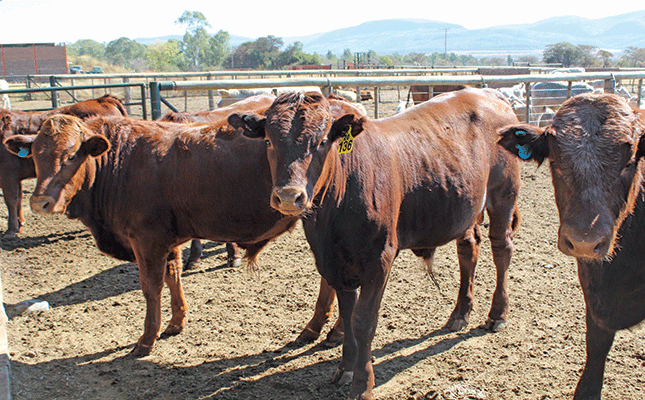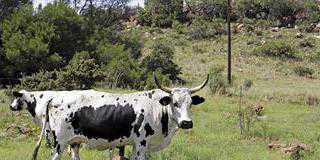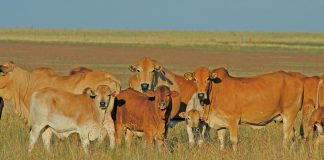
Photo: Lindi Botha
Performance testing of a beef cattle herd entails the weighing of animals at certain ages to determine their genetic value. Data obtained through such tests provide farmers with an objective selection aid to identify the best-performing animals in their herds to be used as parents for the next generation.
This improves the genetic merit of their herds. In a broader sense, the objective of performance testing is to improve the biological and economic efficiency of beef production of a particular herd, breed, and eventually the national herd.
Since the continuous selection of better cattle by all breeders ultimately leads to an improvement in the national herd, the Animal Improvement Institute at the Agricultural Research Council (ARC) runs the South African National Beef Cattle Improvement Scheme to formulate such tests, which are then conducted by the ARC and private test centres around the country.
Tests are available for five phases of the animal’s life, each adding an additional selection criterion to give the breeder a complete picture.
Phase A evaluates the cow herd, taking weaning weights of their calves into account to determine mothering abilities. Ease of calving (birthweight), fertility (age at first calving and inter-calving period) and cow efficiency are also evaluated.
Phase B looks at post-weaning weight gain to measure the adaptability and post-weaning growth of calves.
Phase C is a standardised test in which bull calves’ post-weaning growth is tested at central testing centres. Post-weaning growth rate and individual feed conversion ratios are evaluated under intensive conditions.
The Phase D farm growth tests are where bull calves of the same breed are tested for post-weaning growth and efficiency.
Phase E is the final assessment and entails a carcass evaluation, where the qualitative and quantitative carcass traits of the progeny of a sire are evaluated following a growth test.
Phase D for greater profit
While each phase of testing is important, Lukas Eksteen, who farms cattle on the family-owned Bufland farm in Mookgophong, Limpopo, has seen first-hand the benefits of implementing Phase D testing.
“Profitability of an animal is determined by feed conversion. A 10% improvement in feed conversion can lead to a 43% improvement in profit. But if your growth improves by 10%, your profit only increases by 14%. So while growth is a factor, feed conversion is a bigger one in determining the profitability of a livestock operation.”
He explains that because farming livestock requires a lot of capital and gives a low return on investment, focusing on good genetics is all the more important.
“There are always bulls that aren’t performing as they should. You wouldn’t necessarily know that unless you tested them, because visually they look good. But sometimes they look good because they eat too much, and that extra feed costs money.
“We have a feedlot on the farm and are therefore especially focused on the feed that goes in, and the meat that comes out. The feed conversion figure needs to be as favourable as possible for the economics of the herd, and the feedlot, to work. Since 90% of all cattle go through a feedlot before they reach the market, it is in every cattle farmer’s best interest to ensure they are breeding with genetics that will give them the best conversion of feed into beef, and thus the best prices for their weaners.”
With this in mind, the Eksteen family decided to erect a Phase D bull testing centre on the farm in 2014.
“The testing centre gives us another selection method to ensure we can move forward with the best genetics. Since the centre is a capital-intensive operation, we decided to do it on a scale that would allow other farmers to use the facilities as well,” says Eksteen.
He notes that a bull’s calf is the final indication of how good that bull really is. “[The bull’s] calves ultimately need to perform in the feedlot, and Phase D testing gives you figures that show exactly how well they perform. This gives you certainty about your decision when selecting bulls because, often, two bulls will look the same, but differ on performance figures. It also eliminates the risk of making decisions based on sentiment or love for a specific animal.
“With the data in hand, we can focus on more efficient animals a lot earlier on in the process. We don’t have to wait for a whole growth cycle to see whether the bull performs. This means that we save on opportunity costs because we aren’t wasting space, feed and time on inefficient animals.”
The testing process
Bulls entered into Phase D need to arrive at the test centre at least six weeks before the testing starts. They are inspected for any obvious reasons to cull them before they receive their first round of vaccines. The bulls spend two weeks together in order to socialise and determine dominancy.
On days -22 and -21 of the test, the bulls are weighed on empty stomachs and sorted into their groups, by age and weight, for the test.
On day -1 and 0, the bulls are weighed once again on empty stomachs to set the starting weight, and to finalise the groups. The final round of vaccinations will also take place at this stage. The test then continues for 84 days, and the bulls’ growth is monitored by weighing them every 14 days. A newsletter is then sent to all the participants and stakeholders so that they can keep track of their bulls.
The bulls are fed a ration that consists of 96,4% natural sources of protein, energy and roughage; the core ingredient is maize silage. Bufland’s target average daily gain (ADG) is 1,5kg/animal.
Eksteen says that weight gain does differ from breed to breed, but farmers should not accept bulls that add less than 1,2kg/day.
“Our feed is formulated for weight gain of 1,5kg/ day. We can push for 2kg, but this would be detrimental to the animals, as that amount of pellets is not good for the rumen. They also need to be able to go back to the veld after the test phase and back to a normal grass diet, which would be problematic if they had become used to such a high concentration of pellets. It is also unnecessary, since the desired data can be achieved from [an ADG of] 1,5kg, and any more feed just ends up costing the farmer more.”
He notes that farmers should see a consistent increase in the feed conversion rate to know that they are selecting the right breeding stock.
The test results show a multitude of figures, and Eksteen warns against ‘fatal fixation’.
“A farmer can sometimes get so focused on improving one trait that others fall by the wayside.
“It is therefore important to aim for a balance across the figures, rather than extremely high numbers in any [one] area.
“I always aim for weaners that aren’t too heavy, since it puts less strain on the cow.
“However, you should be looking at average to above-average weaners. I aim for average to above-average growth, and above-average feed conversion.
“We’ve also noticed there is more value in a longer animal, not necessarily a higher animal, as the length has an impact on the slaughter percentage. There hasn’t been a lot of research on this, but it’s clear from the animals that are selected as high performers that they are longer.”
Eksteen says an additional benefit of obtaining good figures from the tests is that weaners from these bulls are in higher demand by feedlots, since they are assured of animals that perform.
“On the flip side, it’s important that any bulls that don’t perform well aren’t sold as second-class bulls, but rather culled. Otherwise, the weaker bulls re-enter the national herd and end up weakening the gene pool.”
Email Lukas Eksteen at [email protected].










